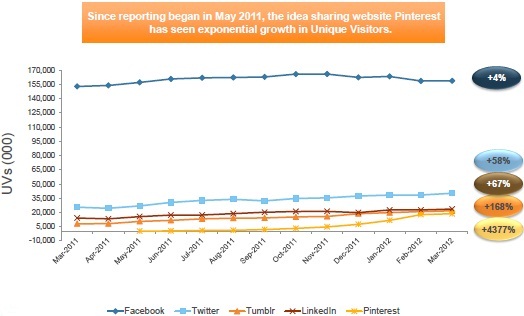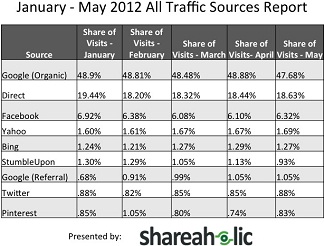All of the buzz around Pinterest has been settling down gradually over the last few months since the photo-sharing site’s traffic growth has been shrank. In fact, since Pinterest crossed the 20 million visitors mark on March, there are even indications for a traffic decline.
But even if Pinterest’s traffic has dropped a bit recently, it doesn’t appears that it’s drastic and I definitely wouldn’t refer it as a crisis. Perhaps the small descent it’s just the natural retrace, which often occurred after a fabulously rapid rise before that.
On comScore’s overview of the internet state in the U.S. for the first quarter of 2012, it shows that Pinterest was the fastest growing social networking site for the previous 12 months. From March 2011 to March 2012, Pinterest’s unique monthly visitors have increased by no less than 4377%, more than any other social network.

But since March it appears that Pinterest’s growth remained more or less flat and certainly not demonstrating the amazing visits increase compared to what it used to be previously. According to data from both Alexa and Compete, since May, Pinterest’s number of unique monthly visitors has actually even declined a bit.

Additionally, it also seems that Pinterest’s referral traffic to other websites doesn’t manage to take off compared to other social networking sites since the beginning of the year. According to Shareaholic, which collects data from over 200,000 sites, Pinterest’s share of visits to other sites hasn’t changed since January and it’s down by more than 20% since its peak on February.

On the latest funding round by Pinterest, where it raised $100 million by a valuation of $1.5 billion, the company signaled it is seeking a global expansion. According to another report of comScore, until April Pinterest achieved some success of doing that at least on Latin America.
comScore’s stats are showing that while on January Pinterest had 153,000 visitors from Latin America, in April it already jumped by 8,500% to 1.3 million unique visitors where the lion shares came from Brazil (27.8%), Mexico (16.1%) and Argentina (10.2%). It’s important to mention that those numbers don’t include mobile devices, so Pinterest penetration to Latin-America is probably much broader.
To approach furthermore this increasing Latin audience, Pinterest presented at the beginning of the month (June) a Spanish translation of the site which can contribute to a stronger growth of the social networking site among Spanish-speaking countries.
